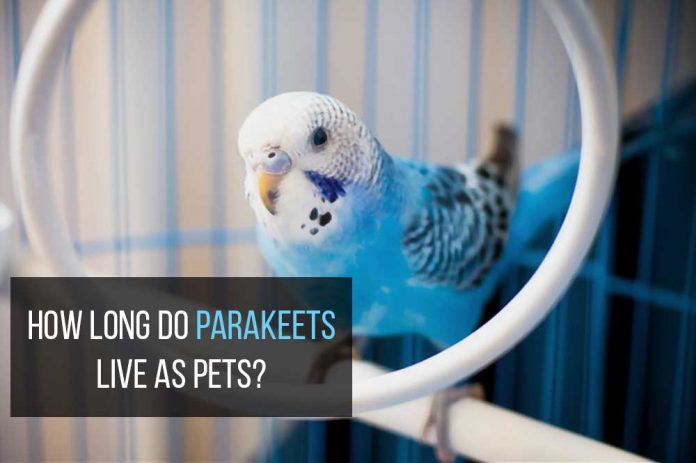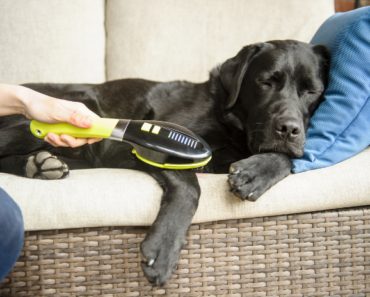Parakeets are great pets – quizzical, colorful, intelligent and adorable. If you own a parakeet, or more than one parakeet, one of the first questions on your mind will probably be: How long is it going to live? If you play your cards right, your parakeet could live up to 20 years. If you don’t provide proper care, this could lead to a much-reduced longevity.
How long do budgies live as pets? The short answer is that parakeets can live up to 20 years in captivity if properly cared for. But on average, most domestic parakeets live between 5 to 14 years. This will also depend on what type of parakeet species your pet belongs to. How do you properly care for a parakeet? Read on to find out!
Budgies, or parakeets, can be categorized into 3 species, each with a slightly different common lifespan.
- Budgerigars – these are small, gregarious Australian parakeets that are green with a yellow head. They typically live up to an average of 5 to 10 years
- Monk parakeets, also known as Quaker parrots, live up to an average of 15 to 20 years. These are actually ‘true parrots’, rather than parakeets, but who needs more name confusion now?
- Plain parakeets live up to an average of 15 years. These birds are endemic to Brazil, and are known for their small stature, symmetrical and proportional features, and slender figure.
In this guide, you’ll learn all about the best ways to care for parakeets, to allow them to live long, full and happy lives. But before you get to know about all the long-term things you should do, it’s super important to know about what NOT to do.
There are 6 things that can cause sudden and untimely deaths in parakeets. Some of these apply to other pet animals, especially smaller-sized birds with high metabolic rates. As long as you ensure against all of these, you can move on to proper parakeet care!
6 common causes of sudden death in pet parakeets
Parakeets are relatively small, and fragile in many ways. Their digestive, respiratory and immune systems require particular temperatures, types of nutrition and social inputs to remain healthy.
Losing your parakeet to a communicable bird disease, or malnutrition, or even high stress levels, can be incredibly saddening. Here are the top 5 causes of sudden death in pet parakeets. Watch out for these, and you shouldn’t have anything to worry about!
#1 Improper diet
Fresh fruits and veggies are important. The same goes for you! Parakeets need a varied but balanced diet, and plenty of water. Dehydration can be a killer, so ensure a constant supply of clean water.
Instead of giving your parakeet regular birdseed, why not splash out on a seed mix that is specifically designed for parakeets? Parakeets are intelligent, and their proportionally large brains require nutrition! These seed mixes often contain dried fruit and higher calcium levels. Low blood calcium can be a killer, too.
Spruce up your parakeet’s diet with small pieces of fresh raw fruits and vegetables. A variety of nuts, seeds and fruits will ensure a broad nutritional cross-section, and will help maintain a healthy, happy parakeet!
#2 Hunger
How long do parakeets live without food?
Parakeets have exceptionally fast metabolisms. You might think that, because dogs and snakes can all go a few days and still recover, parakeets can do the same. This isn’t true! Parakeets have a very active metabolism – they are small, quick and flighty. As a result, they can easily become ill after just 24 hours of not eating. After 2 or 3 days, your parakeet may not survive.
How long do parakeets live without water?
With water, it is the same. A parakeet can last a day or two without water, but just because it can doesn’t mean it should. Make sure your parakeet’s water supply does not run out for more than a day, if you want to keep it healthy!
#3 Overheating
Pay attention to your parakeet’s environment and how it might change throughout the day. If you only check on your parakeet in the morning and evening, you won’t know how hot its cage gets during the warmest hours of the day. An open window may afford a lovely fresh breeze, but the beating afternoon sun can be deadly.
Keep this in mind when transporting your parakeet – it should not be left in a car unattended. Also, keep your parakeet’s cage away from direct heat sources, such as fireplaces, air vents and space heaters. Better safe than sorry!
#4 Stress
We’ve all experienced stress in some form or another. We know how it affects our bodies. It makes it hard to sleep, we become grouchy or irritable – sometimes, it even makes us ill.
Stress is the silent killer of many pet birds. Why? There are many reasons. They are not supposed to be kept in cages, for one; they may not be used to human contact or company; and they might not be accustomed to a captive diet. There are lots of things that can easily stress a bird to the point of illness.
Keep an eye (and an ear) out for certain things that can cause stress. For example, dogs barking, loud traffic, invasive television sounds, cats stalking close by or the mere presence of vermin, such as mice. If you bring a bird into your home, it is your responsibility to house it in a way that keeps it stress-free.
#5 Toxins
Parakeets’ delicate nervous systems are vulnerable to toxins that won’t affect you. Insecticides and strong paint fumes can have harmful effects. Some foods can be surprisingly toxic. Caffeine, chocolate, avocado, peanut and onions are among the most typically harmful foods to stay away from.
Did you know? Cooking near your parakeet using a non-stick pan that has polytetrafluoroethylene (PTFE) in its coating can kill your bird without warning. PTFE is also found in other objects, such as irons, which require a non-stick coating. So watch out for those.
#6 Common illness
Diseases are nasty. Symptoms can cause intolerable suffering. But what if I told you there were killer parakeet diseases out there with no symptoms? Chlamydiosis, otherwise known as ‘parrot fever’, can affect all birds, and is often transmitted from healthy birds carrying the dormant organism. It causes tumors that often go undiagnosed. Symptoms can be as undetectable as faint lethargy, or loss of appetite.
What is the best way to avoid parrot fever? Make sure your parakeet is healthy at the point of purchase. Do your best to avoid bringing your parakeet into contact with other birds that may be infected. Otherwise, keep her healthy!
Parakeet care: Tips to prolong you parakeet’s life expectancy
Keeping parakeets doesn’t need to be a challenge. As long as you provide a few basic things, and make sure they get the proper nutrition, it should be a breeze. Here’s what you need to do…
Provide a proper cage
The best parakeet birdcages provide ample space for parakeets to spread their wings and fly, so they can live a happy, healthy life.
There are a few things to think about when choosing the best cage. The first thing is to get one big enough. Next, only buy a cage that is of solid build. If it is of good build, your cage should last the lifetime of your parakeet. Wire cages are appropriate for birds, and the taller the better. A deep, sturdy base is ideal for placement of seed and water cups. A debris guard will help to keep waste and debris inside the cage.
Cage size is important
Exercise and space keep parakeets healthy – as with just about any animal, even sloths! To prevent muscular atrophy, parakeets need to be able to fly around. Confining them to cages all day everyday will reduce your parakeet’s lifespan. Whatever your cage size, you must let your parakeet out of its cage at least once a day.
What size is best?
Cages come in a variety of sizes. Small are small and designed to house just one bird. Others are larger and tall enough to house a variety of birds simultaneously. Consider how many birds you plan to house before committing to a particular cage size.
Here are some cage ideas to think about…
- Hagen Vision Bird Cage Model M02 – this is a medium size cage, suitable for two or three parakeets, with dimensions 24.6″ x 15.6″ x 34.3″
- Prevue Hendryx Flight Cage – this cage is suitable for multiple small birds, such as parakeets, or medium-sized birds. Its dimensions are 26″ x 14″ x 36″
- Yaheetech 69-inch wrought iron bird cage – this is a larger cage, suitable for multiple parakeets. It is a little bit more expensive, but might be worth it if you are expecting more than a couple of birds to join your aviary!
Keep the cage temperature right – not too cold or hot
Parakeets, along with many other birds, are sensitive to changes in temperature. Their small bodies and fast metabolic rates mean they are vulnerable to the cold and hot.
Parakeets do best in moderate climate, with an ideal temperature range between 60 and 70 degrees Fahrenheit (15°C to 21°C). That being said, they can withstand heat of up to 85 degrees Fahrenheit (29°C) without getting uncomfortable.
These birds can handle a nighttime low of around 40 degrees Fahrenheit (4°C). When temperatures fall below 40 degrees Fahrenheit (4°C) or exceed 90 degrees Fahrenheit (32°C), a parakeet will become uncomfortable, and potentially unwell.
If they get too cold, parakeets can develop hypothermia. If they get too hot, they can suffer heat stroke. Both are bad, but the heat stroke is more dangerous. Hypothermia sets in over a period of days, while heat stroke can kill a bird in less than an hour.
Clean the cage frequently to maintain hygiene
You should clean your parakeet’s cage once per week. An easy way to do this is to layer the bottom of the cage with newspaper. Simply remove it when the time comes, and voila! If there are bits of debris or waste stuck to the cage itself, just spot clean those with a cloth. Wear gloves if it makes you feel more comfortable!
Parakeets typically poop a few times per hour. So you might need to clean your parakeet’s cage more than once a week, especially if you house several birds together.
After you remove the newspaper from the base of the cage, use mild dish soap and water to wipe the base clean. Harsh chemical cleaning fluids may harm your parakeet.
While you’re at it, spray down your parakeet with a Bird Spray. This will cool it off, and can be a fun game to play with your pet. Bird Spray is available here.
Another way to ensure cleanliness is to set up a bird shower inside the cage. Parakeets like to clean themselves, and splash around for fun. Just make sure to change the water regularly to keep it clean!
Provide a healthy diet
There is some information on diet in the ‘common causes of death’ section of this guide, but it is worth repeating! It is vitally important to provide adequate nutrition to your pet parakeets throughout their whole life.
You might think that simple birdseed is enough. Sure, it will provide basic sustenance, but it should only form a sixth of your parakeet’s overall diet! Why is that? It is because birdseed alone does not contain all the nutrients your parakeet needs to live a healthy and happy life. Too much birdseed could lead to obesity, cancer, or other health problems.
Build the rest of your parakeet’s diet from a combination of fresh fruits and vegetables (dark green or yellow ones, mostly), dried fruits, boiled eggs, shredded cheese, and other mineral-rich consumables such as cuttlebones or mineral blocks.
Here is a short list of some fruits you can feed your parakeet:
- Grapes
- Banana
- Apple
- Mango
- Coconut
- Papaya
And here are some suitable vegetables:
- Spinach
- Squash
- Broccoli
- Carrots
- Pumpkin
- Sweet potato
- Parsley
- Cilantro
- Lettuce
Make sure the food you give your parakeet is raw. Cooking can denature some of the minerals they require. Other than that, variety is the spice of life. Mix it up a little! If you do choose to give your parakeet a cuttlebone or mineral block, simply fasten it to the inside of the cage with the soft side facing your bird.
Once again, here are a few foods you SHOULD NOT feed to your parakeet:
- Caffeinated foods
- Chocolate
- Avocado
- Peanuts
- Onion
Proper feeding frequency
Here is a sketched, basic feeding schedule that you might want to start with:
- Everyday foods: some sort of seed/pellet mix
- Every other day foods: fruits, vegetables and other soft foods
- Once a week foods: boiled eggs and shredded cheese
Keep your parakeet happy to reduce stress
Set your parakeet out of its cage often to fly around within an enclosed room. This will allow them to stretch and use their wings, and will help them maintain good physical and mental health.
Parakeets are also highly social, and need to be treated with love and kindness. If you want to get a pet that just sits in the corner, a parakeet is not for you. Many even become hand tame!
At the same time, it is not a good idea to handle our parakeet in the way you would a pet dog. They are small and fragile, and any heavy petting could lead to broken bones.
It may be tempting, but you must not kiss your parakeet. Human saliva carries millions of bacteria, some of which can be toxic to parakeets and other birds. You will have to express your fondness in other ways. Parakeets are highly social, and will enjoy getting to know your voice and mannerisms.
Here are some things you CAN do with your parakeet:
- Talk to it! It may seem silly, but these intelligent, social birds really do enjoy becoming familiar with human voices. This is how they will truly know you. They are also able speakers, and may respond before long.
- Dip your finger in water and then in seeds and encourage your parakeet to eat the seeds from your finger.
- Hold your parakeet in one hand and a larger piece of food (like a banana) in the other, and let them nibble and peck at the food.
- Let your parakeet hang out on your shoulder, or on your body in general. There’s a reason pirates are known as always having parrots on their shoulders! They make great companions, and will enjoy clambering over you, like a climbing frame.
Playtime! Which toys are best?
Toys stimulate the brain and the body. Rather than trivial playthings, they can greatly increase the longevity of your pet parakeet, by keeping them mentally and physically healthy.
There are a great many options out there for parakeets and other small birds. Many accessories are designed to clip onto the inside of birdcages. Others can sit on the base of the cage. Others still are for playing with during recess, i.e., out-of-cage time.
Here are a few options for you to consider:
- Perches, such as…
- Natural Hard Pine Wood Perch, or Natural Wood Bird Perch.
- Some perches are attached to mirrors, which can also provide extra entertainment for your parakeet. They come in natural and fake wood, plastic and other materials. Most perches are very affordably priced.
- Ladders come in all shapes and sizes.
- Ropes also come in a variety of shapes, colors and thicknesses.
- Jungle gyms – this is where things get really interesting. Jungle gyms can really be as big and as ambitious as the designer/manufacturer wants them to be. And this is where YOU can get creative! Here are a couple of ideas to get you started…
Watch out for any abnormal symptoms
There are a few things you should watch out for. The following is a list of red flags. If you spot any of these symptoms in your pet parakeet then consult your registered veterinarian as soon as you can.
- Abnormal breathing – especially quick breathing, as this can be a signifier of ill health.
- Discharge from eyes or beak
- Mucus on feathers
- Abnormal behavior – if your parakeet is behaving erratically, or in an unusually subdued manner, this is a cause for concern.
- Loss of weight – you should monitor your parakeet’s eating habits fairly closely.
- Obesity – if your parakeet loses its streamlined look or becomes obviously lethargic, this can be a cause for concern.
Conclusion
Parakeets are wonderful creatures, and make excellent pets. If you treat your pet parakeet with love and kindness, and give it everything it needs, it could give you up to 20 years of life!
Has this answered all your questions, or left you with more? Let us know in the comments below. Feel free to share this guide with any of your friends or family who are bird lovers.
Do you have any tips for other bird keepers? If there’s anything you want to add to this guide, post it in the comments, and add your voice to the mix!



























